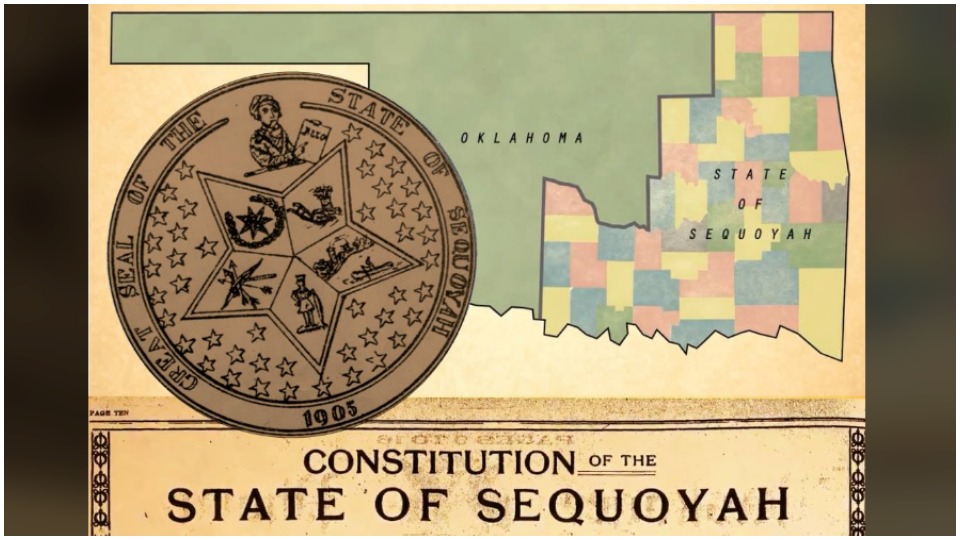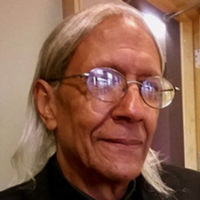
The recent historic Supreme Court decision that the Muscogee Creek land in Eastern Oklahoma is still a reservation brings to mind the valiant efforts of the Five Tribes to fight being brought under the jurisdiction of the state of Oklahoma over a century ago. Their struggle crystallized in the attempt by the Cherokee, Creek, Choctaw, Chickasaw, and Seminole Nations to create the proposed Indian state of Sequoyah to maintain some control and sovereignty over their lands. This resulted in the State of Sequoyah Convention, a tribal movement led by delegates of the Five Tribes meeting in Muskogee in 1905.
The name of Sequoyah was chosen for the proposed state to honor the Cherokee who is credited with inventing a writing system for the Cherokee language (By traditional Cherokee accounts, the syllabary actually existed long before and was revitalized by Sequoyah to strengthen Cherokee culture in the face of white encroachment.)
Some background is required to understand how this novel development came to pass. In 1890, the U.S. Congress passed the Oklahoma Organic Act in preparation for creating the state of Oklahoma. At that time, the land now comprising the state of Oklahoma was two separate territories, Oklahoma Territory to the west and Indian Territory to the east. Indian Territory was composed of the lands of the Five Nations and of course had a large Indigenous population. But by 1890, Indian Territory had a population of 50,000 Indigenous and some 178,000 non-Indians. Due to the sinister machinations of the United States government, the Native people were already greatly outnumbered by a non-Indian populace in the late 19th century in what was supposedly their designated territory.
Up until 1903, the Five Tribes and the small Native tribal nations in Indian Territory had opposed all national and local efforts by non-Indians for statehood. But that opposition changed because subsequently Congress, in egregious violation of sacred treaties—the law of the land, mandated March 4, 1906, as the date for the dissolution of tribal governments and Indigenous communal lands in Indian Territory. Congress sought to combine Oklahoma Territory and Indian Territory into one state, Oklahoma, which would be white dominated and controlled.
Statehood against their will
The Tribes regarded state control with horror, remembering with great bitterness the Southern states’ racist oppression of Native people in their ancient homelands. In 1829, the state of Mississippi extended its laws over Choctaw and Chickasaw land and imposed citizenship on tribal members. Citizenship for Indians of course had a different definition than for whites. Indian citizenship meant the loss of political, legal, and human rights. Native citizens were forbidden under penalty of fine or imprisonment to hold any political office or to exercise any legal rights.
Georgia followed the same course with the Cherokee Nation, forbidding tribal councils from convening except to ratify fraudulent land cessions. Indian individuals were prohibited from testifying in court. Racist white gangs roamed the countryside robbing and plundering at will, cognizant of the fact that Native testimony against them in legal proceedings was precluded. It was illegal for an Indian to bring suit or testify against a white man. This is what state jurisdiction meant to the Five Tribal Republics—the racist rule of the “white man’s law.”
All of the tribes were grimly resolved to never passively surrender to state authority. Tribal leaders, desperate to maintain some aspect of Native sovereignty and avoid state jurisdiction, conceived the idea that Indian Territory, the land of the Five Tribes, be admitted as a single Native American state, set apart from Oklahoma Territory. This sentiment culminated in the State of Sequoyah Convention, which met in August and September 1905.
The convention drew up a constitution, a plan of government, and drafted a map of counties to be established. It elected delegates to meet with Congress to petition for statehood. Congress refused to even consider the petition. Subsequently, President Theodore Roosevelt—a reputed Indian hater infamously quoted as saying, “I don’t go so far as to think that the only good Indians are dead Indians, but I believe nine out of ten are, and I shouldn’t like to inquire too closely into the case of the tenth,”—proposed joining Indian Territory with Oklahoma Territory. Shortly thereafter, the Oklahoma Enabling Act was passed. Roosevelt signed the law in June 1906, and Oklahoma became the 46th state in November 1907.
This ended the last desperate legal efforts to create an Indigenous state. The Native citizens of the Five Tribal republics were smothered by an avalanche of white settlers. Because of racist politics, whites rapidly dominated the new state to the detriment of the Indigenous peoples who had been driven west decades before. Allotments compelling Native families to accept specific acreages of land were forced on the dismantled republics, and the surplus land was given to Euro-American settlers, who took no rest from their transgressions against Indigenous people. The Native citizens looked upon the surplus land made available to white homesteaders as just another instance of land stolen from its rightful owners in violation of treaties that had been promised to last “as long as the grass grows and water flows.”
Before Oklahoma
More mention should be made of the Native republics dismantled with the emergence of the state of Oklahoma. They’ve long been referred to as the “Five Civilized Tribes” by mainstream historians. The term is rightfully considered pejorative, however, because of its European colonialist origins, its implication that these polities adopted white civilization, and the way it ignores the brilliant Pre-Columbian civilizations of the Southeastern nations.
These tribal nations only borrowed very selectively from the white man’s ways, while maintaining dominant Indigenous societal, economic, and cultural attitudes, practices, and mores. Indigenous ethos predominated prior to the era of statehood and thereafter.
Beginning in the early 1800s, migrations of Cherokees began to take place to escape the encroachment of rapacious white settlers. This writer’s great-great-grandfather was among those early émigrés going west.
The southeastern Indigenous peoples surviving the westward travail organized Native republics with written constitutions and adopted some Anglo-American legal practices, but all the while maintaining a dominant Indigenous core. These republics were far ahead of the adjacent white populations and established public school systems teaching in both English and their own Native languages. They set up public mental health facilities, published tribal newspapers, produced schoolbooks, and organized political parties.
As a result of the educational systems established, there was actually a larger proportion of formally educated tribal people than among the white people of the neighboring states. In particular, the Native leaders, bitterly recounting the racist oppression of state and federal authorities, could quote the treaties with such eloquence, fluency, and skill that they easily outdebated their white adversaries.
The political leadership of the Five Nations, who were more often than not better educated than the legislators and governors of the neighboring states of Arkansas and Texas, focused on education as a means of holding at bay the ever encroaching greedy, racist world of white America.
Corporate America coveted the land of the Five Tribes as it was rich in resources, and white settlers, as usual, were its shock troops. The Indigenous republics abounded in rich agricultural land, great reservoirs of oil and gas, huge coal fields, and extensive timber areas.
Land in the republics was held in common. Citizens could use as much land as they could cultivate, and the laws of the nations protected their rights of occupancy and the possession of improvements. But the land, as soon as it was no longer used, reverted to the tribal domain. It was a system that could be referred to as “Indigenous socialism.” This was in opposition to the European concept of private property. The invading white hordes advocating for the dissolution of the Indian republics wanted the communal landholding system transformed into that of individual ownership, which would permit white ownership. That transformation came with statehood.
Destruction of the Indigenous republics
The illegal dismantling of the republics was based on demographic changes—in other words, the burgeoning non-Indian population became the excuse for breaking the sacred treaties. The railroads played a pivotal role in this racist scheme. The genesis of the railroad intrusion goes back to the Railroad Act of 1866, which secured land grants at the geographical expense of the Five Nations. These land grants extended on either side of the railway routes. Towns were founded along the railroad tracks, and white citizens from the neighboring states settled in those towns.
As preeminent Oklahoma historian Angie Debo so aptly stated, the non-Indian immigration “began as a trickle into Indian Territory after the Civil War and became a deluge that engulfed the Indian settlements by the close of the century.” The coming of the railroads meant huge numbers of whites settled in the midst of Five Nations Indian Territory lands. This demographic development resulted in Indigenous citizens being greatly outnumbered in their own homelands.
With the dismantling of the Native republics, the Anglo system of private land ownership was imposed in eastern Oklahoma. The 20 million acres comprising the Indigenous polities that had brought general prosperity to republic citizens now saw stark poverty. Outright hunger suddenly becomes the reality for thousands upon thousands of Five Nations citizens.
Also, with the flood of whites to eastern Oklahoma came the barbaric system of racist discrimination derisively called Jim Crow, which was directed most harshly at African-American citizens of the former republics. It’s reasonable to assume that African Americans dreaded statehood as much as did Native Americans.
A byzantine labyrinth of laws was passed by Congress to destroy the tribal communal land systems, including the General Allotment Act of 1887, the Oklahoma Organic Act of 1890, the Curtis Act of 1898, the Five Civilized Tribes Act of 1906, the Oklahoma Enabling Act of 1906, and the Burke Act of 1906.
The politics of Oklahoma statehood was a traumatic and bitter pill for all the citizens of the republics, which brought to fruition the Sequoyah Statehood Convention Movement. It has been observed by many historians that no other state in the country was settled so rapidly by so many non-Indians from different parts of the United States as was the new state of Oklahoma.
The recent Supreme Court decision is movement in the right direction to begin the correction of long endured wrongs against this country’s Indigenous peoples. All things considered, the restoration of a reservation is better than the reanimation of a lost state.












Comments